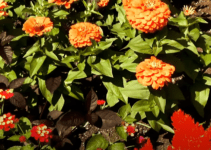There are several things to consider about watering lawns. Whether you have an irrigation system or if you just use a sprinkler, the same rules do apply.

Photo by Pearson Design Group – More exterior home photos
1| Watering techniques should be adjusted during the growing season to compensate for precipitation and lengthy hot and dry periods.
2| The amount of water and the duration of each watering period should be adjusted according to soil types and grass types.
3| Raising your cutting height will also help to retain moisture.
4| When watering your lawn you should only do so early in the morning or in the evening, when the sun is very low in the sky. This will prevent the lawn from burning in the intense mid-day sun, as well as stop unwanted evaporation of the water.
5| Giving the lawn several days between watering will force the roots to grow deeper into the soil where it is cooler and there is more moisture available. This will both protect the lawn from the sun as well as reduce the chance for weeds to take over.
However, the ideal lawn is one that will grow best in your environment without lots of supplemental watering.
Modern Outdoor Design | How To Build A House (howtobuildahouseblog.com)
In fact, how much water does a lawn need?
Generally, turf grasses need about ¾” to 1” of water per week to maintain green color and active growth. During summer when high temperatures are the norm, you should allow lawns to naturally slowdown in growth during those extreme conditions. Many factors also, such as the soil and weather all have a role in the lawn’s water needs.
1/ First of all, find out if your community has watering restrictions. Many communities have responded to water shortages by implementing laws that restrict how many times per week residents can water their lawns, or for how long, and/or at what times.
2/ Water conservation isn’t the only reason to limit the amount of water you give your lawn. Over-watering is also bad for your lawn’s health and can contribute to the development of fungus and disease.
3/ Decide before summer heat and drought conditions arrive, to either water lawns consistently as needed throughout the season, or let lawns go dormant as conditions turn hot and dry. Don’t let the grass turn totally brown, then apply enough water to green it up, then let the grass go dormant again. Breaking the lawns dormancy actually drains large amounts of food reserves from the plant.
4/ Frequent shallow watering encourage weed germination, and they also cause the grass plants’ roots to grow shallow, leaving the plant more susceptible to drought and to certain diseases. Watering only when your grass really needs it encourages the roots to grow deeper, but only if you apply enough water each time to penetrate the root zone.
5/ Avoid midday watering due to excessive evaporation, and at night due to potential increased chances of some diseases gaining a foothold. The exception to this guide is when you are in extremely hot weather and nighttime temperatures don’t go below 68 degrees.
6/ If the lawn has a lot of thatch or the ground is very hard (clay soil) you may need to stop watering several times to allow the water to be absorbed into the ground instead of running off the top. If thatch is a problem you should have your lawn detached.
7/ Spread the water uniformly across the lawn. Sprinklers vary in distribution patterns, and require spray overlap for uniform coverage. Avoid flooding areas, or missing other spots.
8/ Hold off watering after fertilization and hold off fertilizing if heavy rains are expected.
9/ Another thing you might want to keep in mind is not to water your lawn soon before you cut it. This will just help to make everything a mess and it will make cutting the lawn a little more difficult for the mower.
10/ Try to avoid watering on windy days to reduce waste. Position sprinklers to water only the lawn or garden – not the street or sidewalk.
11/ Instead of raking, leave grass clippings on the lawn. Grass clippings decompose quickly, help reduce moisture loss and release valuable nutrients back into the soil.
12/ Don’t water the lawn if rains are expected soon. Keep track of rainfall for the week. Don’t apply more water to the lawn than what is absolutely necessary.


